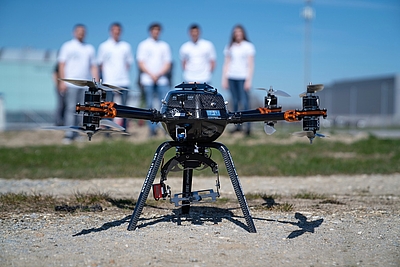
Training and industry closely interlinked
19.07.2024
In an interview, the head of the degree program at the University of Applied Sciences Upper Austria, Campus Wels, Roland Hinterhölzl, explains what makes the "Lightweight Design and Composite Materials" course a unique training program.
What present and future challenges does the course target?
More efficient cars and aircrafts, and producing them in a resource-conserving way, are key in view of climate change and rising energy costs. Rotor blades for wind turbines and a wide range of sports equipment, such as tennis racquets, skis and Formula 1 cars, also have to become even lighter and at the same time comply with the strictest safety regulations. Lightweight design is one of the key topics in the industry. Lightweight construction developments are seeing increasing use wherever moving masses are involved, and this includes robotics or plant construction. Lightweight design and composites make a decisive contribution to achieving climate, resource and sustainability goals. This course of study offers a wide range of opportunities in an industry with great possibilities for the future. It unites innovation, technology and sustainability.
How is the course structured and what specialist topics do the students focus on?
The course is very practically oriented and students encounter lightweight design tasks from the very first session. To give you an example, students developed a lightweight drone where the weight of the supporting structure had been reduced by 40 percent compared to commercial competitors. This made it possible to increase the payload from two kilograms to two and a half kilograms. The project was also supported by industry and the A2LT Platform and is emblematic of the close links between education and industry. The course of studies combines expertise in materials and production technology with training in design and simulation, and by doing so prepares students for the design, layout and production aspects of innovative lightweight structures. Lightweight design focuses on a material independent approach ranging from bionics to optimisation and feature integration with a view to implementing a lightweight system. In the materials fields, students take a deep dive into composite materials and production. This expertise is supplemented by classic lightweight materials such as metals and plastics. The training program is rounded off by excursions to national and international industrial companies and events. This year, for example, our students were again out and about scouting technology at the world's largest composites trade fair, JEC in Paris.
How does the course differ from comparable offerings at other universities?
In the national area, there is no other program of studies in the field of lightweight design and composite materials that even comes close to covering the same material. It is a national and international lighthouse project. In addition to its unique technical position, the course stands out due to its huge practical relevance. One central component of the Master's program, for example, is research and development project work, throughout all terms; this takes place directly in industrial companies, at the University of Applied Sciences or in research facilities.
What career opportunities do graduates have?
The job opportunities are brilliant. There is a massive shortage of engineers in the industrial state of Upper Austria. Just recently, 100 companies (such as, FACC, Peak Technology, SGL Composites, KTM, voestalpine, AMAG, Mubea Carbo Tech, BMW, Magna, Hexcel, Fill, Engel, Fischer, Atomic, Action Composites, Carbon Cleanup, and many more) exhibited at the University of Applied Sciences careers fair in Wels to try to establish contact with the graduates. FACC offers an attractive scholarship while students are still at university exclusively for the Lightweight Design and Composites degree program.
How do industrial companies support the teaching content?
The Lightweight Design and Composite Materials course has very close ties to industry. One key element in this is the involvement of students directly in development and research projects as well as of lecturers from industry. These experts not only contribute up-to-date specialist knowledge, but also provide valuable insights into the actual applications and challenges in the lightweight design and composites sector. In some cases, courses are also partly held directly on the premises of and by industrial partners such as FACC, ENGEL, KTM Technologies, Fill or AMAG. Another core area, especially in the Master's program, is project work at companies and research facilities. These projects, which take place every term, empower students to solve genuine problems and develop innovative solutions in the field of lightweight design and composite materials. Teaching is also closely meshed with the excellent research environment at the University of Applied Sciences Upper Austria and numerous research projects in this area.
About
Roland Hinterhölzl is a renowned lightweight design researcher who gained his first experiences at FACC. He then took over as head of the simulation research group at the Chair of Carbon Composites at the Technical University of Munich. He has been head of the "Lightweight Design and Composite Materials" course at the University of Applied Sciences Upper Austria, Campus Wels since 2016.


